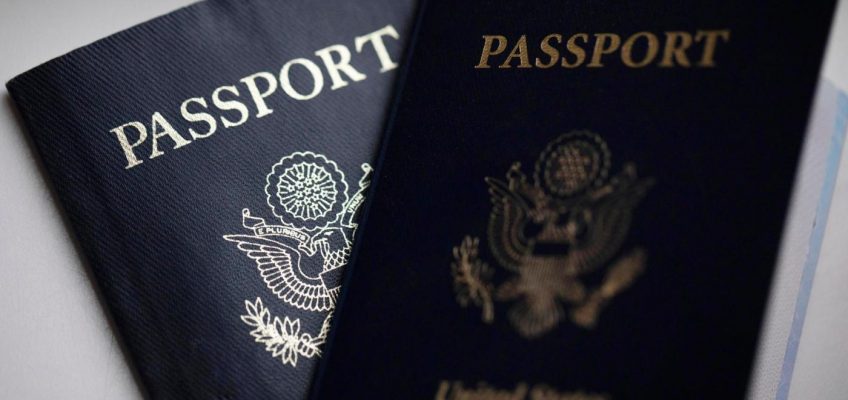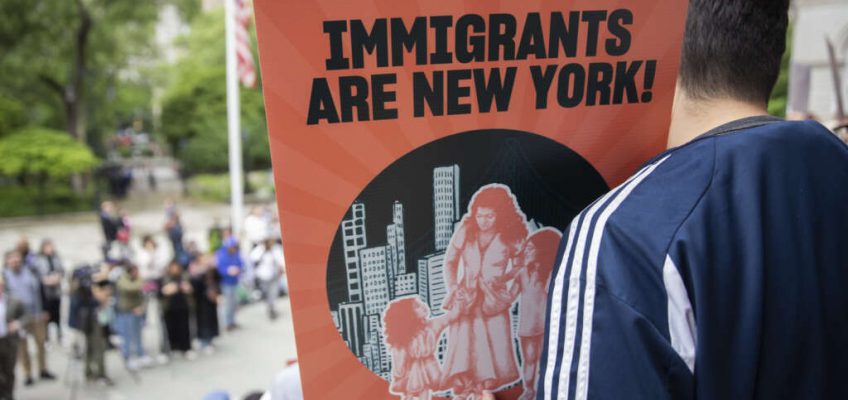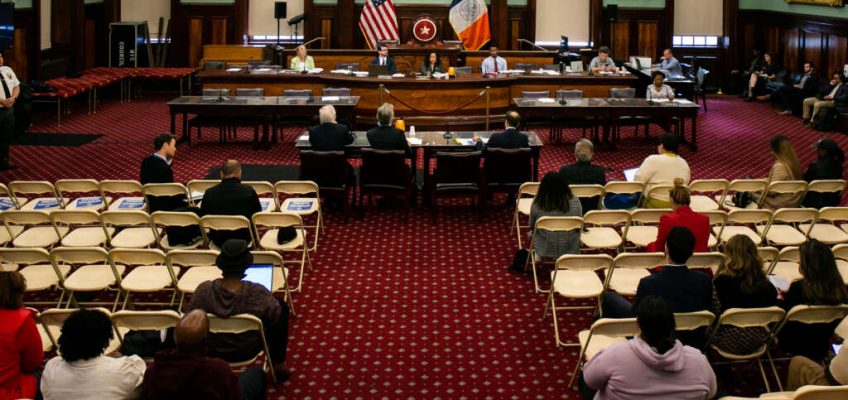This column looks at seven Council races, spanning three boroughs—Manhattan, the Bronx and Queens—that are Latino plurality or majority districts, or have Latino elected representation.
The City Council chambers at City Hall, pictured here in 2022. (Photo by Adi Talwar)
This analysis is part of a series exploring the role of the Latino vote in the city’s 2025 municipal elections. Read more about it here.
With all eyes seemingly glued to the New York City mayoral race, many voters are paying less attention to a number of competitive Council races across the city. A new Council composition will surely have implications for who will be the legislative body’s next speaker, and for the purposes of this article and series, there will be potential ramifications for Latino representation as well.
RELATED READING: A New Rumble in the Bronx—Battle for the Borough Presidency
This column looks at seven Council races in this month’s primary, spanning three boroughs—Manhattan, the Bronx and Queens. These districts are either Latino plurality or majority districts, with two districts that are not overwhelmingly Latino in population but have Latino elected representation.
Manhattan’s District 1 (Financial District, Lower East Side, SoHo, Tribeca)
Incumbent Christopher Marte, a one-term councilmember of Dominican heritage, is locked in a fierce battle against several challengers—Jess Coleman, Elizabeth Lewinsohn, and Eric Yu. Typically incumbents do not mind going up against multiple challengers at once. The conventional wisdom is that having more than one opponent often leads to a split in the anti-incumbent vote, giving an edge to the person already holding the seat.
This time, however, Marte faces a real challenge, for two of his opponents are well funded. Coleman has received the maximum allowed in public financing—$192,543—and has raised $61,710 in private, individual contributions. This has given him a $254,244 campaign kitty, a formidable amount for an insurgent.
Lewinsohn has opted out of the New York City public financing program and has depended solely on private, individual contributions. She has been able to raise a whopping $664,877—an astronomical amount of money in a Council race, especially coming from an insurgent. Just as incredible is her spending: as of the last campaign finance filing, Lewinsohn had already spent $603,255.
Marte, the incumbent, has raised a total of $279,703 of private and public monies. He not only faces one opponent who had double that amount, but has earned the scorn of some local residents who see him as an anti-development advocate at a time when affordable housing is desperately needed.
Marte, for instance, voted against the City of Yes zoning reforms. He retorts, however, that affordable housing is the major issue in his district, and that development should not come at the expense of the displacement of long-time residents who may be priced out of continued luxury housing development.
City Councilmember Christ Marte, who is facing three challengers in this month’s Democratic primary. (William Alatriste/NYC Council Media Unit)
The demographic realities of this district are quite fascinating. Among the registered Democrats, 39 percent are white, a quarter are Asian, and 15 percent are Latino. There’s a small Black electorate, comprising about 3 percent of the district.
Interestingly, of the seven districts written about here, Marte’s is one of two represented by a Latino in a district that is neither a Latino-majority nor a Latino-plurality. Considering likely voting participation, white residents represent 44 percent of the district, Asian residents 24 percent, and Latinos 10 percent. The current dynamics in this race surely makes this a toss-up.
Manhattan’s District 2 (Greenwich Village, Lower East Side, East Village, Midtown South-Flatiron-Union Square, Gramercy, Murray Hill-Kips Bay)
This race is a particularly interesting one. It is an open seat, as Carlina Rivera, the current councilmember, is term limited. The race is between Harvey Epstein, a current Assemblyman, local community activist Andrea Gordillo, Allie Ryan, Sarah Batchu, and finally Anthony Weiner, the disgraced congressman and former mayoral candidate.
In all likelihood, the results of the race will spell the end of over 30 years of Puerto Rican representation in this district. Back in 1991, Antonio Pagan defeated the then long-time incumbent, Miriam Friedlander, in a squeaker of a race. His win was a victory for a Puerto Rican community that had long sought political representation.
The Lower East Side, one of the neighborhoods in this district, had for years been a locus of thriving Puerto Rican activism, and cultural pride has been palpable in the streets, meeting halls, poet dens like the Nuyorican Poets Cafe, and even local churches. It was the artistic birthplace of the spoken word poets Pedro Pietri and Miguel Piñero, and also the place where women like Margarita Lopez developed into fierce advocates of the advancement of Puerto Rican people. In fact, Lopez succeeded Pagan in the Council in 1997.
Current District 3 City Councilmember Carlina Rivera, center, at the city’s Puerto Rican Day parade in 2023. Rivera is term-limited. (Gerardo Romo / NYC Council Media Unit)
Behind Lopez was Rosie Mendez, and then Carlina Rivera replaced the term-limited Mendez. In short, three Puerto Rican women succeeded each other and together represented a Council district for almost three decades. No other district represented by a Latina/o—whether for a Council, Congress, or a state legislative seat—has been able to replicate this remarkable feat.
After next week, this rich history of Puerto Rican representation will come to an end in this district. No Puerto Rican is on the ballot; Andrea Gordillo is of Peruvian descent.
To add further credence to the likely end of Puerto Rican-Latino representation, one must look at the demographic realities of the district. The Democratic electorate is almost half white, followed by Latinos at 19 percent. Asian voters come in third with 10 percent. Black voters comprise 4 percent of all Democratic voters here.
Taking into account likely voting participation, 55 percent of the likely voters in this district will be white. The next closest ethnic group are likely to be Latinos, at 12 percent. Epstein would seem to have an advantage in this race, having represented much of the area in the Assembly, and having earned the support of many local leaders over the years.
Manhattan and The Bronx, District 8 (Mott Haven-Port Morris, Melrose, Concourse-Concourse Village, Upper East Side-Carnegie Hill, Upper East Side-Yorkville, East Harlem)
Moving up north in the island of Manhattan is District 8, which covers a small portion of Upper Yorkville, most of East Harlem, and parts of the South Bronx. The district is a majority-Latino district, mostly people of Puerto Rican descent. Besides District 2, District 8 has the potential to become the only other district to be represented by three consecutive Puerto Rican women.
Starting the trend was Melissa Mark-Viverito in 2005. Mark-Viverito eventually became the first Latina speaker of the City Council. Diana Ayala replaced her because of term limits, and now Ayala will leave after serving her two terms.
Former City Councilmember Melissa Mark-Viverito, who previously represented District 8 and was the first Latina speaker of the City Council. (William Alatriste for the City Council)
Both Mark-Viverito and Ayala have endorsed Elsie Encarnacion, a Puerto Rican woman and Ayala’s chief of staff. But Encarnacion faces strong opponents. She’s one of seven candidates who have earned a spot on the ballot. Among the competitors are Clarisa Alayeto (of Cuban descent), Federico Colon, Rosa Diaz, Wilfredo Lopez, Nicholas Reyes, and finally Raymond Santana, one of the Central Park Five.
The race seems to be coming down to a three-person contest—Encarnacion, Lopez, and Alayeto. It has also earned the attention and financial resources of a number of outside groups that have contributed hundreds of thousands of dollars in independent expenditures. I will say more about this later. For now, suffice it to note that Encarnacion and Lopez have been the beneficiaries of this spending. The race promises to be one of the hottest Council primaries to watch.
The Bronx’s District 13 (Bruckner, Throggs Neck, Pelham Bay, City Island, Ferry Point Park , Pelham Parkway-Van Nest, Morris Park) and District 14 (University Heights, Mount Hope, Fordham Heights, Bedford Park, Kingsbridge Heights-Van Cortlandt Village, Kingsbridge-Marble Hill)
The most northern New York City borough, The Bronx, has two races that are holding my attention, in Districts 13 and 14.
In District 13, six candidates are vying for the seat now occupied by the Republican Kristy Marmorato, who defeated the first Latina ever to represent this district—Marjorie Velazquez. Democratic primary voters will choose among the following candidates: Shirley Aldebol, David Diaz, John Perez, Joel Rivera, and Theona Reets-Dupont.
This race seems to be coming down to Shirley Aldebol and Joel Rivera. Aldebol has earned the support of numerous labor organizations, having herself worked at 32BJ for two decades. And the Bronx Democratic Party has also thrown its support behind Aldebol. She has received $137,191 and, together with the private, individual contributions, has managed to bring in $185,924. With public financing and private contributions, Rivera has brought in $107,824.
Rivera is no stranger to politics. He ran for Council in a different Bronx district in 2013 and comes from a background of activism and non-profit work. His father is the well-known and highly respected bishop, Raymond Rivera. Joel Rivera will not make this easy for Aldebol and will certainly give her a run for her money.
Current City Councilmember Pierina Sanchez, left, is facing off against Fernando Cabrera, right, who previously held the seat. (William Alatriste, Gerardo Romo for the City Council)
To the west we move to District 14, and what may be the most contested Council race in the city. Incumbent Pierina Sanchez will face her predecessor, Fernando Cabrera. A third candidate, Bryan Hodge-Vasquez, is also making a go at it, and has managed to pull in $144,559 between public and private monies. However, because of name recognition and how institutional powers have weighed in, this race will likely come down to Sanchez and Cabrera.
Cabrera represented this district for 12 years. As a result of term limits, he ran for Bronx Borough President in 2021, losing to the current incumbent Vanessa Gibson. Sanchez has earned the support of the Bronx Democratic Party, a number of labor organizations, and has out-fundraised Cabrera. Among her colleagues in the Council, she is known to be a bright and talented representative. However, Cabrera is still known among many of the voters in this district, and for this reason he’ll be a tough opponent to beat.
District 14 has been rocked by rising crime. An excellent Bronx Times profile of the race reminds us that major crimes have risen by 12.75 percent in the 46th police precinct, and 10.94 percent in the 52nd over the past two years. Both precincts reside in this Council district. Will voters in District 14, who are largely concerned about crime and affordability issues, castigate Sanchez at the ballot box? We shall see next week.
Queens’ District 21 (Astoria-Ditmars-Steinway, Jackson Heights, East Elmhurst, Elmhurst, Corona, Rego Park, Flushing-Willets Point) and District 25 (Jackson Heights, Elmhurst, East Elmhurst, Woodside)
District 21 is an open race as a result of Francisco Moya completing both terms. Four candidates are now vying for this seat, which covers Corona, East Elmhurst, Jackson Heights and Lefrak City: David Aiken, Yanna Henriquez, Erycka Montoya, and Shanel Thomas-Henry. Several dynamics have made this race perhaps the one to watch in Queens. First, the still influential Queens Democratic machine has backed Henriquez. Moya has also recently thrown his support behind her. (Moya has been a key Queens machine loyalist, so this support should come as no surprise.)
Interestingly, Montoya, who happens to be a staffer for the current Council Speaker and mayoral candidate Adrienne Adams, has received the support of Congresswoman Alexandria Ocasio-Cortez, Assemblymembers Catalina Cruz and Jessica Gonzalez-Rojas, the Working Families Party and numerous labor organizations.
While many of the candidates backed by the Queens’ Democratic machine have been successful in many parts of the borough, this particular district and its accompanying neighborhoods have been known to back anti-machine candidates. In many ways, it was former Councilman and State Senator Hiram Monserrate who began what would become insurgents bucking machine-backed candidates. And though Monserrate ended his tenure in the Senate in disgrace, he’s largely had success electing district leaders and judges running in these neighborhoods.
This race has in many ways become a proxy battle between the machine candidate versus a candidate backed by progressive organizations and elected officials that have, at times, been willing to buck the Queens’ establishment. And lastly, like the race in District 8, this battle has seen a large sum of money from outside groups.
District 25 incumbent Shekar Krishnan. (Gerardo Romo / NYC Council Media Unit)
In District 25, the incumbent Shekar Krishnan faces Ricardo Pacheco, who also ran two years ago. The district is a Latino-plurality district, with Latinos representing almost 40 percent of the electorate. When factoring in likely voters, the electorate will probably be evenly split across ethnic lines, giving us another indication that Latinos continue to underperform in elections in terms of turnout. Krishnan has vastly out-raised Pacheco, and seems likely to win re-election.
The role of independent expenditures
I feel obliged to insert a closing word on the role outside groups are playing in a number of these races. Ever since the Citizens United decision in 2010, we have seen an eventual proliferation of independent spending in local races in New York. In the current mayoral race, outside groups have spent over $19 million, most of that to support former Gov. Andrew Cuomo’s candidacy.
These outside groups are not limiting their contributions to citywide or statewide races. They’re now also spending heavily on local Council contests. In fact, four of the seven districts examined here have seen the impact of these independent expenditures. Take District 8, for example. Of the seven districts, this one has seen the most money spent for various candidates, with Elsie Encarnacion receiving the most. Almost $600,000 has been spent to boost her candidacy. Wilfredo Lopez has been the beneficiary of $453,578 spent on his behalf, while $279,475 has been spent to support Clarisa Alayeto. All told, over $1.3 million has been spent to influence voters in District 8, one of the poorest in the city.
Over $1 million has been spent in District 21, and close to half a million dollars in District 14. Does the influence of these outside groups in city races, most of which are funded by billionaires and hedge funders, undermine the purpose of the city’s public matching system? The city’s campaign finance law was meant to reduce the influence of big money by establishing a generous public financing program, provided that candidates agreed to abide by certain rules—like establishing contribution limits and banning corporate money.
But the new rules which have resulted from Citizens United have instead made possible a disparity between the regulations governing candidate committees and those applied to outside groups, creating an alarming imbalance. While candidate committees face stringent caps on contributions and expenditures to which I have alluded above, these outside groups operate with no such limitations. This creates an uneven playing field on which entrenched powers can perpetuate their influence unchallenged.
And as we can see from the above, the spending is not limited to affluent districts; more and more, we are seeing this influence in the poorest of districts. Perhaps the next mayor and City Council can tackle some of these issues in the coming year.
Eli Valentin is a former Gotham Gazette contributor and currently serves as assistant dean of graduate and leadership studies at Virginia Union University. He lives in New York with his family.
The post Latino Vote 2025: City Council Races to Watch appeared first on City Limits.




